Choosing the Right Excavator Bucke: A Guide to 11 Types and Their Uses - Bonovo
Excavator buckets are the unsung heroes of construction sites, transforming your excavator from a powerful machine into a versatile workhorse. But with so many different types of excavator buckets available, how do you choose the right one for the job? This article is your go-to guide, breaking down 11 common types of excavator buckets and their specific uses, ensuring you maximize efficiency and get the job done right. Whether you're digging trenches, grading land, or demolishing concrete, understanding your bucket options is key. Read on to discover the perfect excavator bucket to boost your productivity!
Why is Choosing the Right Excavator Bucket So Important?
Imagine trying to cut a steak with a butter knife – frustrating and inefficient, right? The same principle applies to excavator buckets. Using the wrong bucket for a job can lead to wasted time, increased fuel consumption, and even damage to your equipment. Choosing the right excavator bucket is not just about getting the job done; it's about optimizing your excavator's performance, ensuring efficiency, and saving money. Think of excavator buckets as specialized tools – each bucket type is designed for a specific task.
For example, a digging bucket, with its sharp teeth, is perfect for breaking ground and excavating soil. But try using that same digging bucket for ditch cleaning, and you'll quickly realize it's not the most efficient tool. A ditch cleaning bucket, with its wider, flat edge, is specifically designed to smoothly remove debris from ditches without damaging the surrounding banks. By selecting the right bucket, you ensure optimal performance, extend the lifespan of your excavator attachments, and ultimately boost your project's bottom line. At BONOVO, we understand this importance, and that's why we offer a wide range of high-quality excavator buckets to meet every need.
What is a Digging Bucket and When Should You Use It?
The digging bucket is arguably the most common bucket you'll see on an excavator. As the name suggests, this bucket is designed primarily for digging. Think of it as the workhorse of excavator buckets. Its key features include sharp teeth that are designed to penetrate and break up ground, whether it's soil, clay, or even moderately compacted earth. The shape of a digging bucket is typically narrower than other types of excavator buckets, allowing for concentrated digging power.
When should you use a digging bucket? The answer is simple: whenever you need to dig! This includes tasks like:
- Excavating foundations: Creating trenches and holes for building foundations.
- Trench work: Digging trenches for utilities like water pipes, electrical conduits, and drainage systems.
- General excavation: Removing earth for landscaping, site preparation, or other earthmoving tasks.
- Stockpiling materials: Scooping and loading loose materials like soil, sand, and gravel.
For example, if you are used for laying pipes, a digging bucket is your go-to attachment. Its robust construction and powerful digging capability make it essential for a wide range of excavation projects. Remember that the size of the digging bucket will vary depending on the excavator bucket size and the specific job requirements. For smaller tasks, a mini excavator with a smaller mini excavator bucket is ideal, while larger projects may require larger excavator and correspondingly larger excavator buckets.
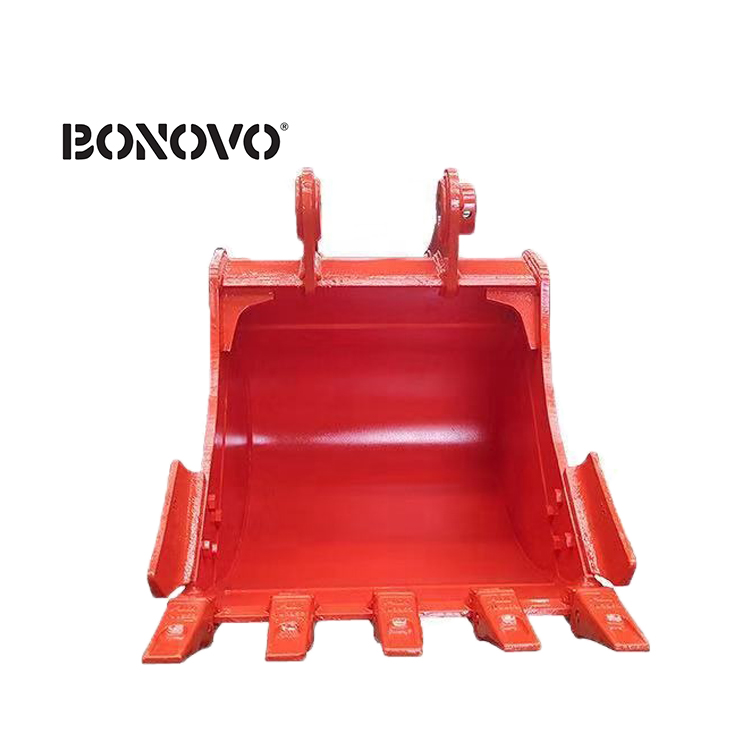
Alt text: General Duty Excavator Bucket
Grading Bucket: What Makes it Ideal for Landscaping and Site Preparation?
While the digging bucket excels at penetrating the earth, the grading bucket is all about precision and finishing. Also sometimes referred to as a clean-up bucket or utility bucket, the grading bucket is characterized by its wide, flat bottom and smooth cutting edge. Unlike digging buckets, grading buckets often lack teeth, or have a minimal number of blunt teeth, as their primary function is not deep excavation but rather leveling, smoothing, and shaping surfaces.
Why is a grading bucket ideal for landscaping and site preparation?
- Leveling terrain: The wide, flat bottom allows for efficient spreading and leveling of soil, gravel, and other materials, creating smooth and even surfaces.
- Backfilling: Precisely backfilling trenches and foundations without disturbing the surrounding soil.
- Slope work: Creating and shaping slopes for drainage or landscaping designs.
- Site cleanup: Collecting and removing loose debris, topsoil, and vegetation from a site.
- Spreading topsoil: Evenly distributing topsoil for lawns and gardens.
The flat edge of the bucket allows for a clean, smooth finish, making it perfect for the final stages of a project. In fact, the grading bucket is known by the nickname “finishing bucket” in some circles! For landscaping projects, road construction, and any task requiring precise surface contouring, a grading bucket is an indispensable excavator attachment. You can even get extra-wide grading buckets, such as an 84-inch grading bucket, for maximum coverage and efficiency on large sites.
Trenching Bucket vs. Ditch Cleaning Bucket: What's the Difference?
Both trenching buckets and ditch cleaning buckets are designed for linear excavation, but they serve different purposes and have distinct features. Understanding the nuances between these types of excavator buckets is crucial for efficient operation.
A trenching bucket, also known as a trench bucket or ditching bucket, is specifically designed for digging narrow trenches. They are typically very narrow, often ranging from 6 inches to 36 inches wide, and feature sharp teeth for effective soil penetration. The narrow width minimizes the amount of material excavated, making them ideal for utility trench work where precision is key and you want to disturb as little surrounding area as possible. Trenching buckets are often used for laying pipes, cables, and drainage systems.
On the other hand, a ditch cleaning bucket or ditch cleaning bucket is designed for maintaining and cleaning existing ditches and drainage channels. These buckets are much wider than trenching buckets, and typically have a smooth, flat cutting edge without teeth. The wide, toothless design allows for efficient removal of silt, vegetation, and debris from ditches without damaging the ditch lining or banks. Ditch cleaning buckets are not intended for digging new trenches, but rather for maintenance and ditch cleaning.
Here’s a table summarizing the key differences:
| Feature | Trenching Bucket | Ditch Cleaning Bucket |
|---|---|---|
| Primary Use | Digging narrow trenches | Cleaning and maintaining ditches |
| Width | Narrow (6-36 inches) | Wide |
| Cutting Edge | Sharp teeth | Smooth, flat edge (toothless) |
| Excavation | For digging new trenches | For removing debris from existing ditches |
| Typical Tasks | Laying pipes, cables, drainage | Ditch maintenance, waterway cleanup |
Choosing between a trenching bucket and a ditch cleaning bucket depends entirely on the task at hand. If you need to dig a narrow trench, go for a trenching bucket. If you need to clean out an existing ditch, the ditch cleaning bucket is the right bucket for the job.
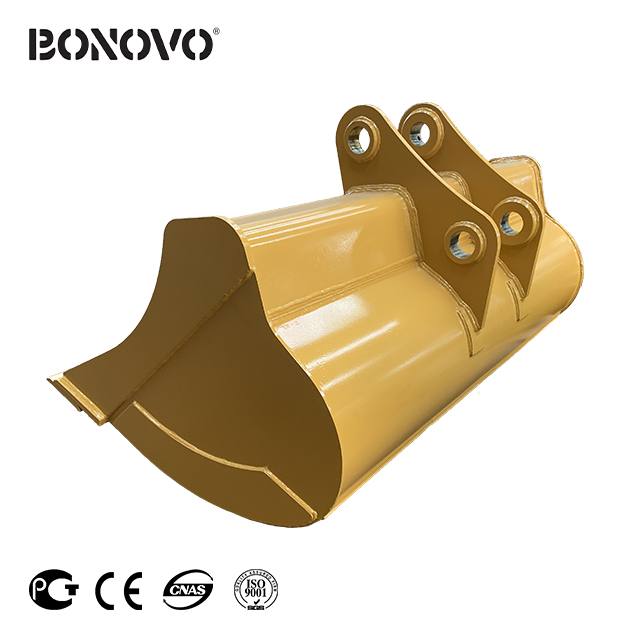
Alt text: Pavement removal bucket can be customized in size
Tilt Ditch Cleaning Bucket: How Does Tilt Functionality Enhance Ditch Maintenance?
Taking the ditch cleaning bucket a step further, the tilt ditch cleaning bucket adds a valuable dimension to ditch maintenance – tilt functionality. This type of bucket can tilt hydraulically, typically up to 45 degrees left or right, allowing for greater versatility and precision when working on ditches with varying slopes and angles.
How does this tilt feature enhance ditch cleaning?
- Working on Slopes: When ditches have sloped sides, a standard ditch cleaning bucket might struggle to clean evenly. A tilt ditch cleaning bucket can be angled to match the slope, ensuring a clean and consistent cut along the entire ditch bank.
- Reaching Difficult Areas: The tilt function allows you to reach around obstacles, under bridges, or in tight corners more effectively.
- Contouring Ditches: You can use the tilt to precisely shape and contour ditch banks to improve drainage and prevent erosion.
- Increased Efficiency: By being able to adjust the bucket angle on the fly, you reduce the need to reposition the entire excavator, saving time and increasing productivity.
Imagine cleaning a ditch with uneven banks. Without tilt, you might have to make multiple passes and still not achieve a clean result. With a tilt ditch cleaning bucket, you can simply tilt the bucket to match the bank's angle and make a single, clean pass. This not only saves time but also results in a better quality of work. For contractors regularly involved in ditch cleaning and maintenance, investing in a tilt ditch cleaning bucket can save contractors a significant amount of time and effort in the long run, representing a significant amount of time saved on each project.
When Do You Need a Robust Rock Bucket for Tough Excavation?
When excavation gets tough, literally, that's when you need a rock bucket. Rock buckets are heavy-duty excavator buckets specifically designed for digging in extremely hard and abrasive materials like rock, heavily compacted soil, and even frost. They are built to withstand extreme stress and wear, ensuring durability and longevity in demanding applications.
Key features of a rock bucket include:
- Reinforced Construction: Made with thicker, high-strength steel to handle the impact and abrasion of rocks.
- Hardened Teeth: Equipped with robust, hardened steel teeth that can withstand the forces involved in breaking and prying rocks. Sometimes these are ripper teeth designed for maximum penetration.
- Wear Protection: Often features additional wear plates and reinforcements in high-wear areas to extend the bucket's lifespan.
- V Buckets Design: Some rock buckets incorporate a V buckets design, which concentrates digging force on the center teeth for better penetration into rock.
When is a rock bucket necessary?
- Rocky Terrain: Excavating in areas with solid rock, boulders, or very rocky soil.
- Demolition: Breaking up concrete, asphalt, and other hard materials during demolition work. A rock bucket might be used to initially fracture materials before using a concrete pulverizer.
- Frozen Ground: In cold climates, a rock or frost bucket is essential for breaking through frozen ground (frost bucket is a specialized type discussed later).
- Mining and Quarrying: Extracting rock and ore in mining and quarry operations.
Trying to use a standard digging bucket in rocky conditions will quickly lead to damage and wear. The teeth that can break, the bucket may bend, and the overall structural integrity can be compromised. A rock bucket is an investment in durability and efficiency when dealing with challenging excavation environments. For heavy-duty applications, a rock bucket is not just recommended; it's essential for protecting your excavator and maximizing productivity.
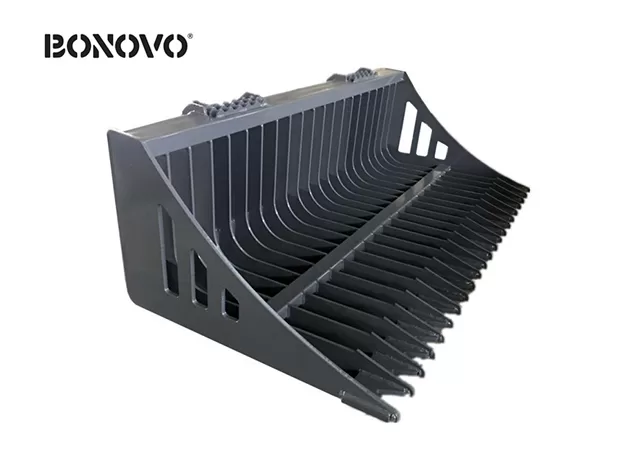
Alt text: Rock Bucket 60-84 inch
Skeleton Bucket or Riddle Bucket: When is Separation Essential?
Sometimes, excavation isn't just about digging; it's about separating materials. This is where skeleton buckets, also known as riddle buckets or rake riddle bucket, come into play. These unique types of excavator buckets are designed with large slots or gaps in the bucket floor and sides, allowing fine materials like soil and sand to fall through while retaining larger objects like rocks, roots, and debris.
When is material separation essential?
- Land Clearing: After land clearing, riddle buckets are ideal for sifting through the remaining soil and removing roots, branches, and larger debris, leaving behind clean topsoil.
- Rock Sorting: In quarries or construction sites, skeleton buckets can be used to quickly sort rocks by size, separating larger rocks from smaller gravel and soil.
- Beach Cleaning: Removing large debris like seaweed, driftwood, and trash from beaches while allowing sand to pass through.
- Recycling and Waste Management: Separating recyclable materials from general waste in demolition or construction debris.
The key feature of a skeleton bucket has large slots, which determine the size of materials that are retained. The spacing and size of these slots can vary depending on the intended application. For example, a rake riddle bucket might have wider spacing suitable for land clearing, while a riddle bucket used for rock sorting might have narrower slots. Using riddle buckets significantly reduces manual labor and speeds up material separation processes, making them valuable excavator attachments for various industries.
Frost Bucket: How to Tackle Frozen Ground Effectively?
Working in cold climates often means dealing with frozen ground. Trying to dig in frost with a standard excavator bucket is not only inefficient but can also damage your equipment. That's where the frost bucket becomes an indispensable tool. A frost bucket is a specialized type of rock bucket specifically engineered to break through and excavate frozen ground.
What makes a frost bucket effective against frozen ground?
- Heavy-Duty Construction: Like rock buckets, frost buckets are built with extra-thick, high-strength steel to withstand the immense forces involved in breaking frozen ground.
- Aggressive Teeth: Frost buckets feature extremely robust and aggressive teeth, often with sharpened points or chisel edges, designed to shatter ice and frozen soil.
- Narrow Profile: Often, frost buckets have a narrower profile than standard digging buckets to concentrate digging force and improve penetration into frozen surfaces.
- Reinforced Cutting Edge: The cutting edge is heavily reinforced to resist wear and impact from frozen materials.
When should you use a frost bucket? Anytime you encounter frozen ground! This includes:
- Winter Construction: Excavating foundations, trenches, or performing any earthmoving tasks during winter months in cold regions.
- Utility Work in Cold Climates: Maintaining or repairing utilities in areas prone to freezing temperatures.
- Road Maintenance: Removing frozen layers of ice and snow from roads and pathways (although other attachments like snowplows are often used for surface snow removal).
Trying to use a regular excavator bucket in frozen ground is like hitting a brick wall. The frost bucket is designed to overcome this challenge, allowing you to continue working efficiently even in freezing conditions. For contractors operating in cold regions, a frost bucket is not just a convenience; it's a necessity to maintain productivity throughout the winter months.
What is a Utility Bucket and its General Applications?
The term "utility bucket" is often used somewhat interchangeably with grading bucket or clean-up bucket. However, a utility bucket can also refer to a more general-purpose excavator bucket designed for a wider range of tasks beyond just grading. Essentially, a utility bucket is a versatile attachment suitable for light to medium-duty excavation, material handling, and general site work.
While utility buckets share similarities with grading buckets in their wider, shallower design compared to digging buckets, they might sometimes feature teeth, albeit less aggressive teeth than a dedicated digging bucket. This allows them to perform light digging as well as grading and clean-up tasks.
Common applications for a utility bucket include:
- Light Excavation: Digging topsoil, loose soil, and softer materials.
- Grading and Leveling: Smoothing surfaces, spreading materials, and site preparation.
- Material Handling: Moving and loading loose materials like mulch, gravel, and topsoil.
- Site Clean-up: Collecting debris, vegetation, and general site waste.
- General Purpose Work: Tasks that don't require the specialized capabilities of a digging bucket, rock bucket, or other specialized excavator buckets.
A utility bucket is a good all-around attachment for contractors who need a versatile bucket for a variety of tasks. It's a practical choice for landscaping, general construction, and site maintenance where heavy-duty excavation is not the primary focus. Think of it as a jack-of-all-trades excavator bucket, capable of handling a wide range of tasks efficiently.
Micro Trenching Bucket: What Makes it Perfect for Narrow Trenches?
In urban environments and projects requiring minimal ground disturbance, micro trenching buckets are becoming increasingly popular. As the name suggests, a micro trenching bucket is designed for digging extremely narrow trenches, typically for fiber optic cables and other small-diameter utilities. These buckets are significantly narrower than even standard trenching buckets, often only a few inches wide.
What makes micro trenching buckets ideal for narrow trenches?
- Ultra-Narrow Width: The defining feature is their incredibly narrow width, minimizing excavation and surface disruption.
- Clean Cuts: Micro trenching buckets are designed to create clean, precise cuts in asphalt, concrete, and soil, minimizing the need for extensive backfilling and surface restoration.
- Reduced Environmental Impact: Narrow trenches mean less soil displacement, less dust generation, and less disruption to traffic and surrounding areas.
- Efficiency in Urban Areas: Ideal for congested urban environments where minimizing disruption is crucial.
- Fiber Optic Installation: Micro trenching buckets are often used for laying fiber optic cables, hence sometimes a micro trenching bucket is known as a fiber-optic bucket.
Using a micro trenching bucket offers several advantages over traditional trenching methods in specific applications. It reduces the amount of excavation, minimizes restoration costs, and speeds up project completion, especially in urban utility installations. While not suitable for all trench work, for narrow trenches and sensitive environments, the micro trenching bucket is the perfect specialized tool.
Excavator Bucket FAQs: Answering Your Common Questions About Excavator Buckets
Choosing the right excavator bucket can still raise questions. Here are some frequently asked questions to help clarify common points:
Q: How do I determine the right excavator bucket size for my machine?
A: Excavator bucket size is typically matched to the size and horsepower of your excavator. Manufacturers provide guidelines based on machine class and operating weight. The larger the excavator, the larger the bucket may be. Consult your excavator's operating manual or your excavator dealer for specific recommendations. Consider the density of the material you'll be handling as well – heavier materials require smaller buckets. For example, a 30-inch bucket might be suitable for general digging, but for very dense materials like wet clay, a smaller bucket may be more efficient.
Q: Can I use one excavator bucket for all types of jobs?
A: While a utility bucket offers versatility, using specialty bucket types significantly improves efficiency and performance for specific tasks. Using the right bucket for the job, even if it means switching bucket attachments, will ultimately save time and money. Think of it like using the right tool in any trade – a specialized tool always performs better than a general-purpose one for its intended task.
Q: How often should I replace excavator bucket teeth?
A: The lifespan of excavator bucket teeth depends on the materials you're digging and the intensity of use. Regularly inspect your teeth types for wear and tear. Replace teeth when they become excessively worn, chipped, or broken. Worn teeth reduce digging efficiency and increase stress on the bucket and excavator. Using high-quality bucket teeth from reputable manufacturers like BONOVO can extend their lifespan and ensure optimal performance.
Q: Where can I find high-quality excavator buckets and attachments?
A: Reputable manufacturers like BONOVO specialize in producing high-quality excavator attachments, including a wide range of excavator buckets. Look for factories with proven experience, multiple production lines, and a commitment to using durable materials like wear-resistant steel. Exhibitions are also a great place to find suppliers and see products firsthand. Online searches and industry directories can also help you find catalogues and connect with suppliers.
Q: What are the key factors to consider when choosing an excavator bucket manufacturer?
A: Key considerations include:
- Quality and Durability: Look for manufacturers using high-quality materials and robust construction techniques.
- Range of Products: Ensure they offer a wide range of excavator buckets and excavator attachments to meet your needs.
- Customization Options: Can they customize buckets to your specific requirements? BONOVO, for example, offers customizable options.
- Warranty and After-Sales Service: Check their warranty terms and after-sales support.
- Reputation and Experience: Choose a manufacturer with a solid reputation and experience in the industry.
By understanding the different types of excavator buckets and considering these FAQs, you can make informed decisions and choose an excavator bucket that maximizes your excavator's productivity and efficiency. Remember that the bucket you use is just as important as the excavator you use itself!
In Summary: Key Takeaways for Choosing the Right Excavator Bucket
- Match the Bucket to the Task: Different types of buckets are designed for specific jobs. Using the right bucket is crucial for efficiency.
- Consider Material Density: Heavier materials require smaller buckets to avoid overloading your excavator.
- Invest in Quality: High-quality excavator buckets made from durable materials like wear-resistant steel will last longer and perform better.
- Think About Versatility vs. Specialization: While utility buckets offer versatility, specialty buckets excel in specific applications.
- Regular Maintenance is Key: Inspect and maintain your excavator buckets and teeth regularly to ensure optimal performance and longevity.
- Consult Experts: Don't hesitate to consult with excavator dealers or attachment specialists like BONOVO to choose the right bucket for your needs.
By carefully considering these factors and understanding the different types of excavator buckets, you can equip your excavator for success on any project. Remember, at BONOVO, we are committed to providing high-quality excavator attachments to enhance your productivity and help you get the job done efficiently and effectively. Explore our range of excavator buckets and other attachments to find the perfect solutions for your equipment needs! Check out our Excavator Buckets and Excavator Quick Couplers for more information. For heavy-duty tasks, our Rock Bucket is built to last. And don't forget to explore our full range of Excavator Attachments to maximize your machine's potential.
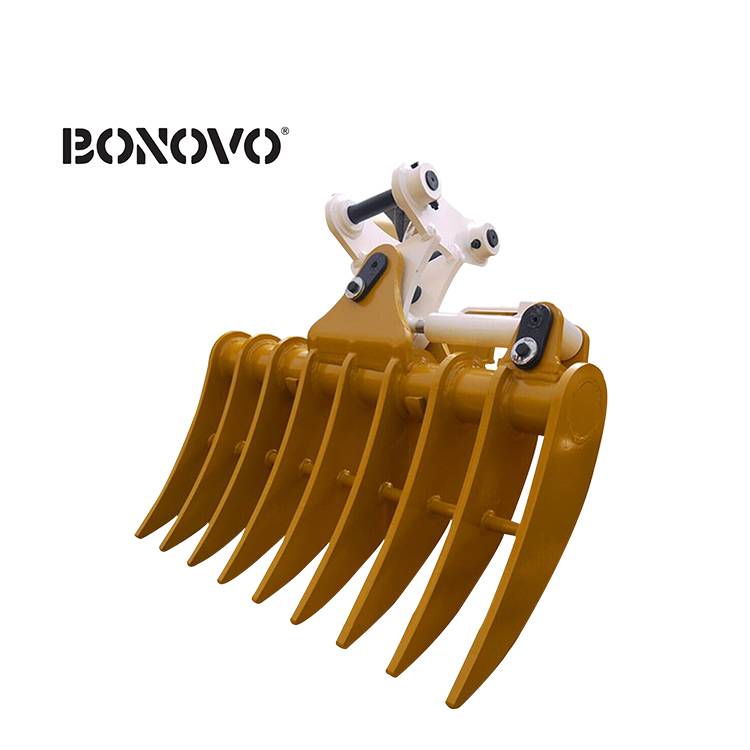
Alt text: Factory price brand new land clearing rakes stick rake for 1-100 ton excavator
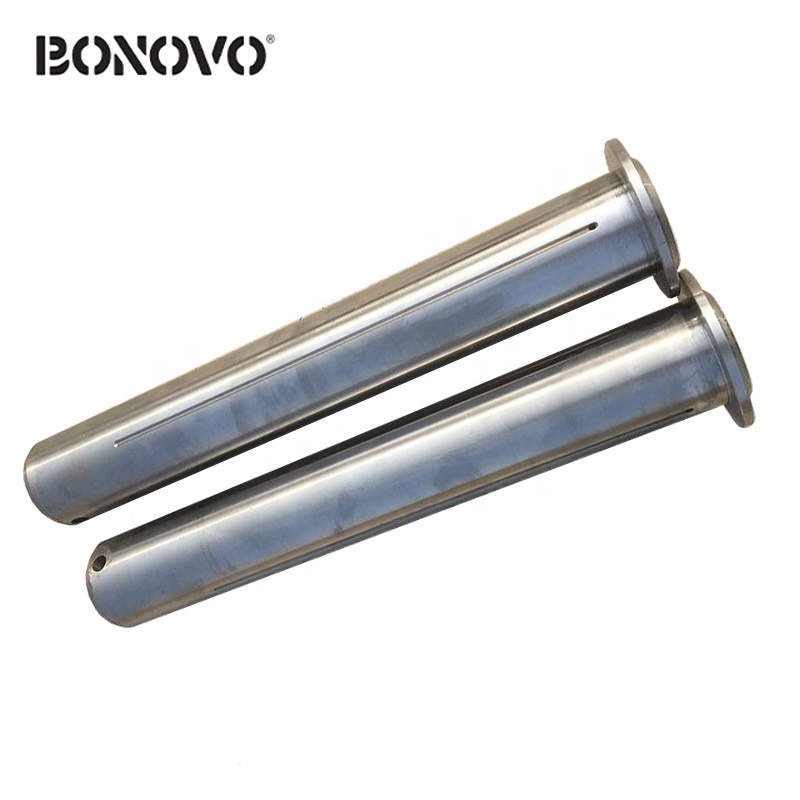
Alt text: Excavator Bucket Pins 30-140 mm
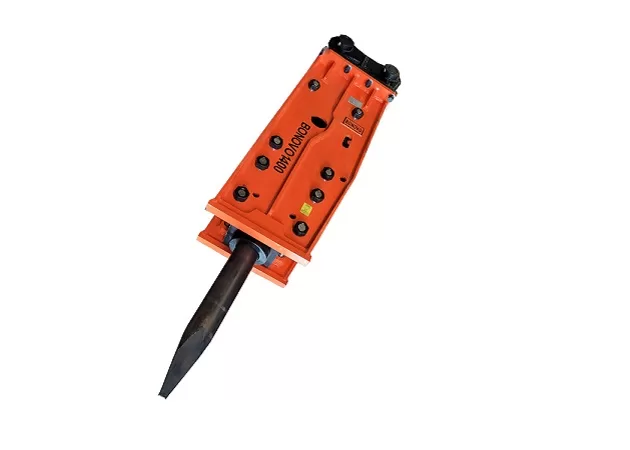
Alt text: Top Hydraulic Hammer For Excavator




